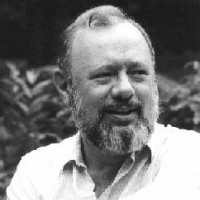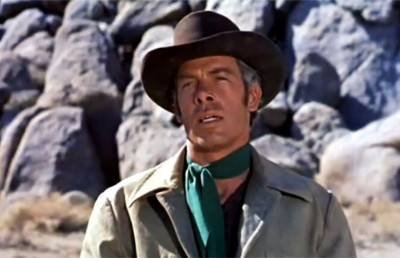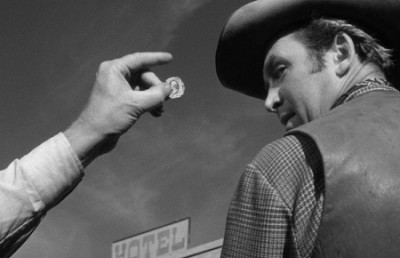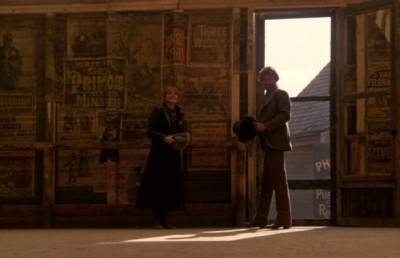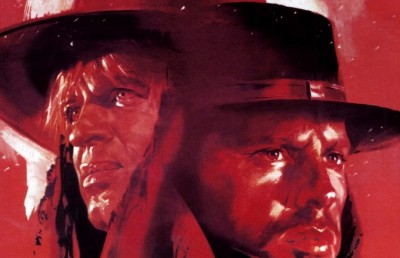Tim Holt and the B Western
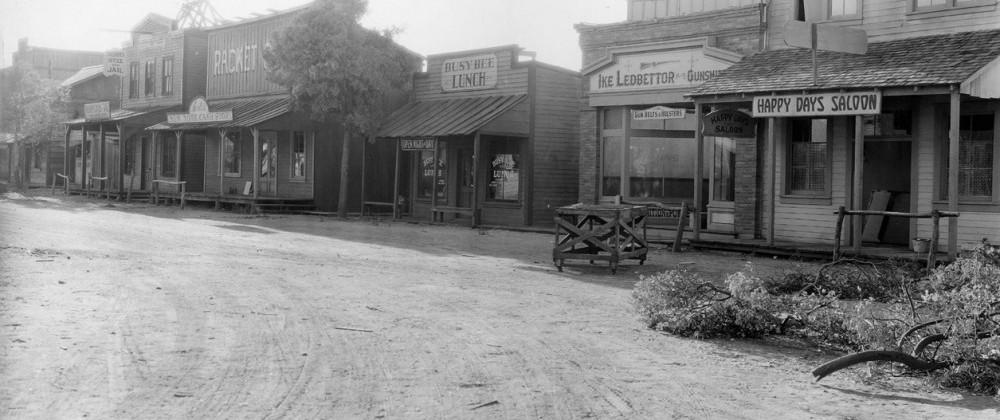
Many years ago, before you could do such things instantaneously on a computer, one film buff made up lists of actors who appeared in what he considered great films. Several movie stars appeared on the actors list: Bogart, Wayne, Grant, Fonda, but one name was unexpected: Tim Holt. Holt appeared in Stagecoach (1939, as a cavalry officer), The Magnificent Amberson (1942, as Georgie Minifer), My Darling Clementine (1946, as Virgil Earp), and The Treasure of the Sierra Madre (1948, as one of the three prospectors). He never became a major star in A pictures, but that was because he preferred his day job. Budd Boetticher, one of his classmates at the Culver Military Academy in the thirties and later a director, recalled to David Rothel that Holt “used to walk around in our suite of rooms there…and he often had on his ’38 revolvers and holster. He’d walk up and down the hall in his bathrobe and practice drawing his guns. He’d say, ‘I’m going to be a western star some day’” (Rothel, 1994: 215). From the early forties to the early fifties, he was exactly that: at his home studio of RKO Radio Pictures he was one of the biggest stars in B westerns.
In the late forties and early fifties I was a kid growing up in Bloomington, Indiana, the home of Indiana University. Nearly every Saturday morning I would go down to one of the two local theatres that showed westerns on Saturdays and see a show that consisted of two B westerns, a chapter of a serial, and several color cartoons. The early show would start at 9:15, and we would then have the afternoon to play cowboys on the main wooded campus of the university. While I saw and enjoyed most of the Holt westerns, I generally preferred Alan “Rocky” Lane, Roy Rogers, and Hopalong Cassidy. While the Rogers and Cassidy pictures hold up reasonably well, the Lane pictures, while having some great action scenes, seem rather flat, since Lane was a block of wood as an actor. A few years ago, I caught a couple of the Holt westerns on the Encore Westerns Channel and they seemed to me, sixty years later, very well made. The following Christmas I got Volumes 2 and 3 of the Tim Holt DVD set. I have been watching them since, and I am more impressed with them the more I see them. This essay started out to be a short appreciation of the films, but the more I got into the films, the more there was to say.
Tim Holt
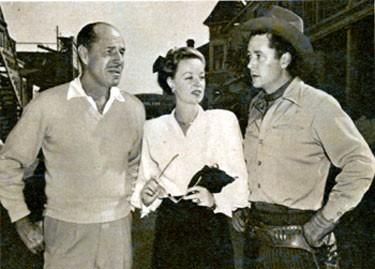
Jack and Tim Holt, who co-starred together in “Arizona Ranger” (‘48 RKO), with Jennifer Holt, daughter of Jack and sister of Tim. Photo and caption taken from Western Treasures, see bibliography for link
Holt was born on February 5th, 1919, the son of Jack Holt. Jack Holt started in films in 1914, was a star in silent and early sound films, later moving to supporting roles. He appeared with his son twice, once uncredited as a flophouse bum in Treasure of the Sierra Madre, and once as his father in one of Tim Holt’s westerns, The Arizona Ranger (1948), which alas is not part of either of the three volumes of Tim Holt DVDs. Tim Holt grew up in the movie business, so it never had the glamour for him it did for others (Rothel, 1994: 39). He got into acting in the late thirties and was put under contract at RKO. Holt’s earliest roles were in non-westerns, but in 1938 he starred with Harry Carey in one of the more haphazard movies of the time, The Law West of Tombstone. Carey plays a combination of Buffalo Bill, Judge Roy Bean, and Pat Garrett, with a young Holt playing a version of Billy the Kid. Holt seems right at home in westerns. When George O’Brien, who had starred in a western series for RKO left the studio in 1940, RKO decided on Holt as his replacement.
From 1940 to 1942 Holt made eighteen westerns. They were well done, but rather conventional. Since Holt looked even younger than he was, he was paired up with two sidekicks. The first was Ray Whitley, who was slightly older than Holt. Whitley was also a songwriter and singer and usually performed a song or two in each film. The other sidekick was of the more conventional comic variety. The first was Emmett Lynn and he was followed by Lee “Lasses” (as in slow as molasses) White. Both played the same character, Whopper, but White was older and bearded, as many sidekicks were. In 1942 they were replaced by Cliff Edwards as Ike. Edwards was a bug-eyed vaudevillian who played the ukulele, sang, and did the usual sidekick slapstick routines.
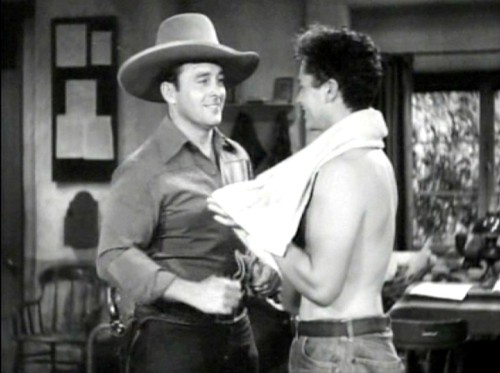
Holt (right) with George O’Brien in Renegade Ranger, 1938
Several of the 1940-1943 westerns are on Volume 1, but two of them are on Volume 2, Sagebrush Law and The Avenging Rider. Both films were shot in a burst of activity from May 11th to July 17th 1942, when Holt made six westerns (Rothel 1994: 78.) RKO wanted him to finish a year’s worth of films before he went into the Army, and these two were released in 1943. Both are conventional, and Sagebrush Law (directed by Sam Nelson) has an exciting fistfight between Holt and Roy Barcroft (and/or their stunt doubles) on top of a moving stagecoach. In The Avenging Rider, we get a lot more than we need of Edwards comic turn as a slight-of-hand card magician. Both films, like all the 1940-1943 films, were shot in nearby locations, such as the Iverson Ranch and Corriganville in the North San Fernando Valley, where most B westerns were filmed.
There are some elements that look forward to the later 1947-1952 series. Cyclone on Horseback (1941) features a livelier heroine than is usual in B westerns. Holt, unlike many other B western stars, played characters not named Tim Holt. From his debut in 1934 Gene Autry always played “Gene Autry” and after 1941 Roy Rogers always played “Roy Rogers,” but Holt’s names varied, even if the basic character he played is the same. To avoid confusion, when I am talking about Tim Holt the actor, I will call him Holt, and when I am talking about his character in a film, I will just call him Tim. In these early films Tim’s jobs were diverse. While Hopalong Cassidy was always the foreman of the Bar 20 Ranch, Tim played a cowboy, a Treasury agent, a Texas Ranger, or a number of other occupations. The characters were pretty much the same: Tim, with his boyish good looks, is drawn into situations where he must right some wrongs. Holt had a charming personality on the screen, which made him one of the top western stars from 1940 to 1943, but he left his heavy acting to The Magnificent Ambersons.
Holt was a bombardier on B-29s for the Army Air Force during World War II. He got out of the service in December 1945 (Rothel 1994: 22-23). RKO wanted him back and in 1947 released his first post-war B westerm. As his biographer David Rothel notes, the war had affected him: “No more was he the callow, youthful cowboy with big, silly grin on his face. Now he exuded a steady, serious no-nonsense type of mature cowboy who was less impulsive, more contemporary, and somewhat ‘world weary.’” I am not convinced Tim was “world weary,” although you may see some of that in his initial reluctance to get involved in trouble. Like most heroes in American films (Rick in Casblanca [1942] or Terry in On the Waterfront [1954]; see Suber 2006: 316), he at least says he wants to avoid the problem. These being sixty minute B pictures, Tim is not reluctant for that long. He also shows his charm. While Holt had lost his baby fat during the war, he still had a wonderful grin and cute dimples. He used the mixture of charm and seriousness very well.
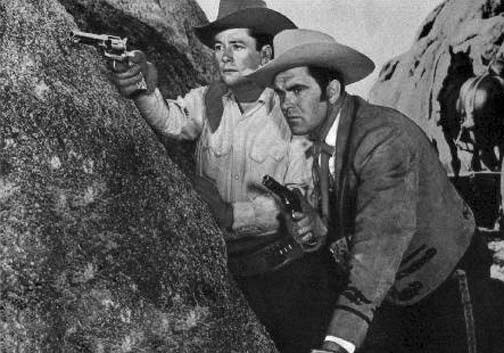
Chito Jose Gonzales Bustamente Rafferty
In the 1940-1943 westerns Tim had several sidekicks. In the 1947-1952 series, he had only one: Chito Jose Gonzales Bustamente Rafferty, played by Richard Martin. Chito was not a new creation when he first appeared in a Holt western in 1947. His first appearance was not even in a western, but in the 1943 World War II film Bombardier. Martin’s friend Jack Wagner, a screenwriter from the silent comedy days, was brought on to add gags and funny bits and he started to develop the character of Chito: a young, handsome Mexican-American whose family has lived in California for decades. Chito loved girls, and he misspoke the English language, but in subtle, amusing ways rather than in grotesquely obvious ones. Martin was a hit in the part, and RKO decided to try him as a western sidekick. Holt had gone off to war, so Chito was paired with a potential new star in the 1944 Nevada (Rothel, 1994: 182). The new star had played some bad guys in several Hopalong Cassidy films and the studio thought he had possibilities. He was not as likeable as Holt, and his presence suggested something darker. There was not much chemistry between him and Martin, and after one other western, the studio realized the new star might better in films noir. He made Crossfire and Out of the Past (both 1947), and when the studio did put him in westerns again, they were what might be called western films noir, like Pursued (1947) and Blood on the Moon (1948). He was Robert Mitchum.
The chemistry between Holt and Martin was immediate. Tim was entertained by Chito’s constant pursuit of the ladies, which gave Holt a variety of reactions to play: amusement, surprise, slight irritation, bafflement at the hopelessness of Chito’s attempted conquests. Unlike Hopalong Cassidy’s young sidekick Lucky, who just mooned after girls, Chito was active, which was a lot more interesting to watch, especially with Tim’s reactions. Chito was not just a lovesick fool, but also ready for action. As he explained his name, his mother was Spanish, and the Spanish is for loving, and his father was Irish, which is for fighting. Chito performed the crucial functions of a B western movie sidekick: he was somebody with whom the hero could discuss the plot, and he provided some comedy relief. In the 47-52 series, the comic relief is verbal rather than visual, and often a part of the story. The directors can shoot both Chito’s flirting and Tim’s reaction in one shot. Unlike other B westerns, such as those Holts with Cliff Edwards, the movie does not have to stop while the comic does his routine. It makes for much smoother flowing films.
Chito was not a clichéd Mexican-American. He was not fat, greasy, with a large sombrero, a big moustache, and an over-the-top accent, as in, say, Treasure of the Sierra Madre. The same was true of the other Latino characters who show up in the films, such as Captain Trevino of the Mexican police in Rio Grande Patrol (1950). Chito was elegantly dressed, usually the same in each picture, whereas Tim’s outfits varied a bit from film to film. Traditionally B westerns stars wore the same costume in each picture, which made it easier to repeat shots from one film to another, but Holt was more interested in dressing like real cowboys dressed. He also wore gloves, as real cowboys do. (If you watch the Holt westerns and want to start a drinking game, take a drink every time Tim tugs at his gloves.) Walter Reed, an actor in three Holt films, needled Holt about the glove business. Holt was offended until he realized it was a joke. Reed told Rothel, “that was very good ‘business’ for his hands in the scene…I hate to see a guy just stand there with his hands at his sides, and it looks awkward for a cowboy actor to put his hands on his guns all of the time” (Rothel 1994: 200-201).
The WomenIn most B westerns, the women characters were either the daughter of the rancher, the banker, or the sheriff, or the niece of the rancher, the banker, or the sheriff. While there had been at least one lively woman in the 40-43 films, the 47-52 have a striking galley of female characters. Yes, some are the dance hall girls Chito flirts with, but even those often have more to do that just react to Chito. In Law of the Badlands (1951), the dance hall girl Velvet has known Chito before and inadvertently lets the villain know he and Tim are Texas Rangers and not the outlaws they pretend to be. In Border Treasure (1950), the saloon singer Stella, an old flame of Chito’s, actively works for the bad guys. The only out-and-out evil woman in the films is Gypsy, the wife of the land developer in Rider from Tuscon (1950). She turns out to be the mastermind of the gang.
In addition to the saloon girls, women get to do a lot more in the Holt westerns. In Indian Agent (1948), Tim and Chito interrupt a wagon under Indian attack. It is carrying a large printing press to their town to set up a newspaper. But the editor is not the man in the wagon, it is the woman, Ellen Wheeler. She is determined to start the first newspaper in town. When there is a shootout in the streets on her arrival, she thinks it is exciting and wishes the press was up and running so she could put out an Extra edition. Later Chito brings a baby that has been left at their ranch to her, not because she is a woman, but because she’s said she is looking for stories for the paper. She later helps Tim get out of jail after he’s been unjustly accused. Yes, Chito flirts with her and the other strong women in the films as well as the saloon girls.
In Border Treasure, the woman leading the action is Anita Castro, a Mexican-American woman putting together a column of relief wagons for victims of an earthquake in Mexico. In most of the scripts for the Holt films, there is not much description of the characters, but in this script the writer Norman Houston describes Anita in some detail: “She is one of the finer type of Spanish Americans you will see, occasionally, throughout the Southwest; the ‘aristocratic’ sort with the straight nose—-no Indian blood. Her costume is Spanish, but her English is flawless. She was probably educated in a fine school, maybe college.” Anita of course sees through Chito and after a half page of them talking in Spanish, Houston writes, “Anita realizes that Chito must be some sort of wolf. She pulls away a little from him and turns toward Ed [Tim]” (RKO: Box 1665s).
In at least three of the films, the writers let us assume that a character is a man before revealing the person is a woman. In Saddle Legion (1951), the doctor is a woman. In Gun Play (1951), the ranch owner who has hired Tim and Chito turns out to be a woman. In Target (1952), the townspeople send for the famous marshal Terry Moran to help deal with the bad guys. At twenty minutes into the sixty minute film, Terry Moran shows up, but she’s the daughter of the famous Terry Moran. He is indisposed and she has come in his place. The head of the town does not like the idea of a woman doing the job, but she quickly shoots a row of knickknacks off his shelf, one after the other. On the other hand, it is Tim Holt’s name above the title, and it is Tim who brings the bad guys to justice.
While Chito handles the romance in all the films, Tim does see a bit of action. In Pistol Harvest (1951, not in the DVD sets), Tim is engaged to be married to Felice at the beginning of the film. Her father is killed and robbed, and Tim has to get back the father’s money. In The Stagecoach Kid (1949), a sort of western remake of It Happened One Night (1934), Jessie is the daughter of a rancher who drags her back to the ranch in Arizona to keep her from marrying a man he does not approve of. She gets off the stagecoach at one stop and disguises herself as a boy. Tim ends up having to take care of him (her), including putting him across his knee and spanking her. When she later reveals to him that she is a girl, he says he knew it all along, but there is nothing in either the script or Holt’s performance that suggests he did. And we are very surprised at the end of the film when we find out Tim and Jessie are getting married. There has been no sexual heat between them. At the end of Road Agent (1952), Chito tells Tim he will show him how to kiss Clara, but Tim says, “What makes you think we need lessons?” And Tim kisses Clara, with the movie ending with a closeup of Chito looking as astonished as the little boys in the audience probably felt. Watching that scene, I had the suspicion that it may have been adlibbed during production, but a check of the screenplay drafts in the RKO Studio Collections in the UCLA Special Collections (RKO: Box 1520s) shows it was in the script from the beginning.
Most of the actresses in the Holt films were adequate at best (although some were worse than that, particularly after Howard Hughes took over the studio in 1948 and hired starlets for other than their acting skills). Like many of the males on the films, some of the actresses loved making westerns. Nan Leslie, who appeared in six of the Holts, preferred going on location to make B westerns rather than doing A pictures. She recalled, “Yes, the Westerns [sic] were pure pleasure, and some of those other things (A-budget pictures) were just plain hard work; you were shut into sound stages all day long” (Rothel, 1994: 195).
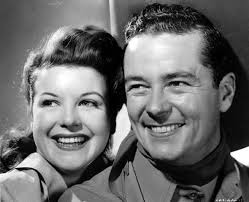
Holt with Nan Leslie in Under the Tonto Rim (1947)
The most interesting actress showing up in the Holts is Dorothy Malone, five years after her striking appearance in The Big Sleep. She co-starred in Saddle Legion as the woman doctor. Like Mitchum in his B westerns, her presence overpowers the genre limitations of the B western. The other women in the B westerns tended to be cute rather than sexy, but Malone’s look and voice were sex personified. So when Chito flirts with her Ann, Malone is way beyond that kind of B western cuteness. In the RKO Collection, this is one box (RKO: Box 1447s) that has a first draft screenplay. The other script boxes have a draft labeled an “Estimating Script” as the first item in the box. This box has an earlier draft dictated 10/24/49 to 11/11/49, then an Estimating Script dated June 27, 1950, with a Final Draft dated July 3, 1950 and changes dated July 10, 1950. In the first draft when Chito meets Ann and starts flirting, “She is surprised and almost overwhelmed.” By the Estimating Script, “She hides her amusement.” In the Final Draft when she first sees Chito in her office, “She glances over him and is pleased with what she sees.” One might think that the script was being adjusted for Malone, but in the production box (RKO: Box 191p), there is a cast list dated the same as the Final Draft, and Malone has not yet been written in. However, given the way the script was developing, one can understand her being cast in the part.
Malone’s sexual presence upsets the usual dynamics of the B westerns, and the filmmakers may have realized that Malone’s Ann would have eaten Martin’s Chito alive. In the changes on the script a long scene where Ann comes out to visit Chito and Tim while they watch the cattle has been condensed, with a lot of the flirtation between Chito and Ann dropped, including him singing to her. On the other hand, in the course of revisions, the final scene gets an added line for Chito. As he and Tim leave to take the cattle to market, Chito says to Ann, “You make sure you wait until I come back.” Since the end of the Holt westerns usually involved Chito running or riding away from girl who wants to marry him, the ending of Saddle Legion is a little more adult.
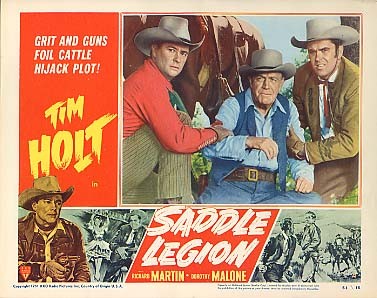
How did the women in the Holt westerns come to be so interesting? It may have been Holt, since there was the one earlier film with a livelier than usual heroine. It may have come from the writers, but it is in films with different writers. My guess is that it came from the producer of the 47-52 series, Herman Schlom. Since it is consistent through the films, it is more likely from the producer. That first draft of Saddle Legion gives us at least a bit of circumstantial evidence that it was Schlom. In the first draft, Ann is a veterinarian rather that a medical doctor, which makes sense since in the film she is dealing with a possible cattle epidemic. By the Estimating Script, she has been upgraded to a medical doctor. Her reactions are more of an adult. Those kinds of changes either come directly from the producer, or the writer working with the producer.
So who the hell was Herman Schlom?
Richard “Chito” Martin said of Schlom, “Herman was one of RKO’s best B producers. He could get a lot of quality into a picture for a few dollars. He lived with the pictures he was producing twenty-four hours a day, trying to refine them, make them better. He fought for excellent music backgrounds and outstanding photography” (Rothel, 1994: 192). He was very cautious with the company’s money. Martin had a horse that slobbered over his leather jacket when Martin carried carrots and sugar as treats. Schlom was upset that they had to get the jacket cleaned too often (Rothel, 1994: 189-190). Martin also liked Schlom, since the producer would have Holt and Martin come in for a couple of days to go over the script with the writer to suggest changes. Martin recalled, “They’d always listen to me if I found my dialogue difficult because of the dialect. They’d generally rewrite it. The writer was very open to making changes if we came up with something that was funnier for me to do or say. The whole idea was that everybody was trying to make come up with something that would make the picture better.” That may be how Martin remembered it, but in the script files for the eight Holts I looked at in the RKO files, there is only one of Chito’s speeches that is changed from the Final Draft. All the other blue page changes deal with shortening scenes, or changing names. It is, however, possible that these meetings were done before the Final Draft.
According to the IMDb, Schlom was born in Russia in 1904, and first worked in Hollywood as a second assistant director on the 1931 Dracula. By the mid-thirties he was a producer at Republic Pictures, a studio specializing in B movies. He moved to RKO in 1940. In addition to westerns, he also produced B movie films noir, such as the neat little 1950 thriller Armed Car Robbery and the 1949 Follow Me Quietly, which includes almost every cliché of film noir, but then ends with a chase in a great location, the Hollywood gas works. Most of his postwar work was on the Holt westerns.
Schlom was smart enough to hire Norman Houston as the primary writer for the Holts. A native of Texas, Houston had been a playwright, director and actor in New York in the twenties, as well as writing many stories for silent films. He wrote the dialogue for Broadway Melody, the 1929 Academy Award winner for Best Picture. In the thirties he got into writing screenplays, and in the late thirties, he was one of the primary writers for the Hopalong Cassidy films. When Harry Sherman, the original producer of the Hoppys, left to make A pictures, Houston eventually found his way to Schlom and started writing the Holts. He wrote Holt’s first postwar western, Thunder Mountain, and then nineteen more. He, more than any of the other writers of the Holts, had the perfect light touch in writing the Tim-Chito relationship. He also tended to nail the script so that not a lot of changes were made after it was accepted. There are Final Drafts of scripts of his that have no blue pages, which was the color used for revised pages. Houston’s plotting could get a little sloppy. In Rio Grande Patrol, the man we take to be the primary bad guy disappears for a long time while Tim and Chito track down his henchmen.
Ed Earl Repp wrote six of the 47-52 Holts. He had written for other B western stars such as Charles Starrett (The Durango Kid) and Eddie Dean. He also could handle the Tim-Chito relationship, but he could be even sloppier in the plotting than Houston. In Law of the Badlands, Repp has Tim and Chito as Texas Rangers tracking down counterfeiters. At the end the bad guys have Tim and Chito trapped in a building. Tim has been communicating with the Ranger office some distance away by carrier pigeon. Now he sends a message for help by pigeon –and the Rangers arrive before Tim and Chito run out of bullets. On Guns of Hate (1948), Repp’s first Holt screenplay, Houston was brought in to do revisions, and there are more blue pages in the script than any of the eight other films whose files I looked at (RKO: Box 1339s).
The stories Houston, Repp, and the few other writers came up with for the Holts were mostly conventional B western stories. Tim and Chito, whatever their jobs, would get involved in stopping criminals, most likely led, as in all B westerns, by a man in a suit with a moustache. The details changed and there are only occasional variations of what has been used before. In his script for the 1949 Brothers in the Saddle, as much a drama as a western, Houston has Tim trying to keep his bother from being seduced by gambling. In his script for Riders of the Range the following year, Tim is trying to help the brother of the heroine also avoid problems with gambling. Houston’s scripts for both Dynamite Pass (1950) and Road Agent deal with unscrupulous toll road owners.
By the late forties most scripts for studio A pictures were written in the Master Scene format. A scene heading was given describing the location and then all the action at the location was included in the scene. It was then up to the director as to how to shoot it. In B films in general and the Holts in particular, the writer broke the scenes down into shots, with descriptions of the camera angles. Each of these shots was listed on the production reports as scenes. It was not uncommon for the directors to shoot several of the scenes in one camera setup, so that on the Daily Production Reports, there were often more scenes than setups. On May 11, 1948 on the production of Indian Agent, director Lesley Selander shot 58 camera setups of 87 scenes (RKO: Box 173p). The directors often would not follow the screenwriter’s breakdown of how a scene should be shot, but the writer’s version at least gave the director a sense of what the writer thought the important elements were in each scene.
The director whom Schlom hired for the first of the Holts was Lew Landers, whose credits went back to the early thirties. He had directed two Gene Autry westerns, as well as B westerns with other stars, but he also did contemporary action pictures, horror movies, and comedies. He was a perfectly competent craftsman, but perhaps because of his work in comedy, he let Jeff Donnell, who played Jessie in The Stagecoach Kid, overact. He directed four of the Holts.
The man who directed the most Holts and did the best job was Lesley Selander, who had worked with Houston on the Hoppys in the thirties. Selander primarily directed westerns and his IMDb page notes he is credited with 107 westerns, the most of any director. He was fast, shooting up to sixty camera setups in a single day. He had an unerring sense of what needed to be in the shot, which many directors do not have. There was nothing extraneous in Selander’s stagings, and the shots focused on exactly what was needed to tell the story. In B movies there was no time for the director to be “creative,” i.e., filling up the shot with unneeded detail, something directors of A movies sometimes do not understand.
PIX of Cimaron set
Storm Over Wyoming [1950] was the only Holt shot in Agoura, but that was because it was about sheep and that’s where the herd was. Most of the 47-52 Holts were shot on three exterior locations. The first was the standing western street set on the RKO Ranch in Encino. The street had originally been built for RKO’s superwestern Cimarron (1931), but then remodeled throughout the thirties. The street ran east to west on the lot, with an easily recognizable two-story building with four second story windows at the east end. The major saloon, which had many names over the course of its life, was on a corner halfway up the street on the south side of the street. The west end of the street had less elaborate buildings and a railroad depot. Generally one does not see a lot of trains in B westerns, since they are expensive to run. Hot Lead (1951), the only Holt film on the two DVDs involving trains, has a gang trying to rob the train in the depot, which looks as stupid as it sounds. Scholm did not have the budget for the kind of big train scenes that A westerns like Dodge City or Union Pacific (both 1939) did. The preferred method of transportation in B westerns was the stagecoach. In A westerns they were pulled by a team of six horses, while in B westerns they were pulled a team of four. You could move a stagecoach and horses much more easily to distant locations than you could a train, they did not require railroad track, and the horses cost less to feed.
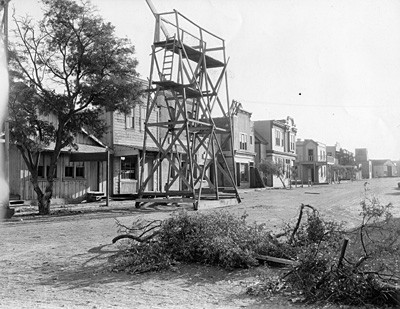
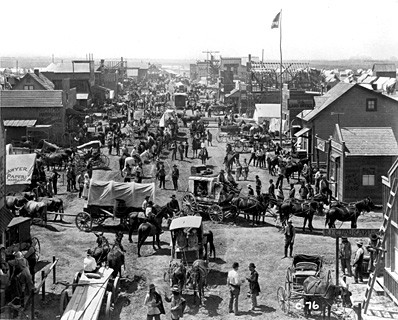
The RKO Encino Ranch, Cimarron set, 1935 (these, and many more, photos from RKO Ranch website linked below)
Fans of B westerns began to recognize the studio western streets. They were not the only ones. In the 1949 Riders of the Range, as Tim and Chito ride into town, Tim looks around and says Norman Houston’s line, “It seems to me that all these cattle towns look alike.” In his script for Dynamite Pass the following year, Houston has Chito say, as they ride into the far east end of town, “This doesn’t look like a cow town to me,” which may be because the shot is closer to the end of the street than the usual longer shot.
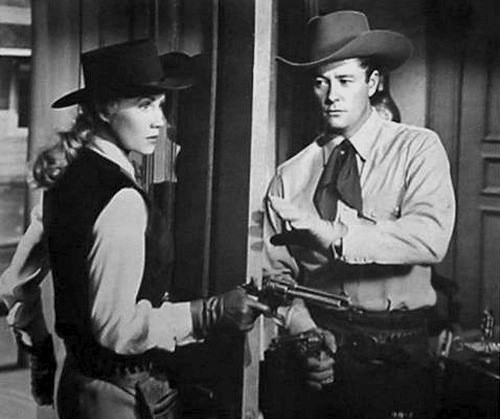
Jacqueline White (Priscilla “Dusty” Willis) with Tim Holt
The second major location was the Alabama Hills, outside of Lone Pine, California. Two hundred miles north of Los Angeles, the Alabama Hills have been used as a location for over 350 films (Holland, 2005: 89; see also Rothel, 1990: 54-83) since the twenties, including A pictures such as Gunga Din (1939) and Django Unchained (2012). Most of the movies made there were the B westerns from the thirties to the fifties. Thirteen of the twenty-nine 47-52 Holts were shot in the Hills. The Alabama Hills were particularly suited for B westerns. Lone Pine is only one day’s drive from Los Angeles. The Hills are between Lone Pine and the eastern side of the Sierra Nevada Mountain Range, so the mountains make a great backdrop, giving the pictures a size those shot in the San Fernando Valley do not have. There is a wide variety of rock formations in the hills, great for both good guys and bad guys to hide from whomever is chasing them. There are also long stretches of dusty trails, including one called the Movie Road where Holt and every other western star rode. But for the B movie directors, the Alabama Hills had another great advantage. While the Hills are only three miles west of Lone Pine, there is a wall of rocks that you pass through to get to the Hills themselves, which puts the town out of view once you get into the Hills. To the east of Lone Pine are the Inyo Mountains, not as large as the Sierras, but still clearly mountains. The advantage of the geographical layout is that once you are in the Hills, you can point the camera in any direction and see hills and mountains with no sign of the town. On an A picture, you take as much time as you like, setting up the shots, but if you are doing 50 to 60 setups a day, you can just shoot in any direction. Lesley Selander first shot in the Hills on his Hoppys, and was very much at home there. Richard Martin said of Selander, “We called him the ‘jumping gazelle’ because he would run from one rock to another at Lone Pine setting up shots. The cameraman would come huffing and puffing behind him with a camera.” Because of the number of rock formations in the Hills, every film could look a little different if, like Selander, you made an effort to find a variety of angles.
If the Alabama Hills stood in for the arid, dusty American Southwest of Texas, Arizona, and New Mexico, the third major location stood in for the high county, the Sierras and the Rockies. It was the Jack Garner Ranch near Idyllwild, California. The ranch was, and still is, a working cattle ranch. It was 9,500 acres in the forties (Jack Garner Ranch website, accessed October 30 2013) and like the Alabama Hills, played host to several western film shoots. Five of the 47-52 Holts were filmed on the ranch. The ranch sits in what is called Garner Valley in the San Jacinto Mountains southwest of Palm Springs. Visitors are not encouraged at the ranch, but driving past the ranch on State Road 74, one can see a large meadow. But the large meadow never shows up in the Holt pictures. The smaller meadows closer to the mountains were used, probably because a smaller meadow means you have to rent fewer of the Garner cattle for the shoot. Tim and Chito were often cowboys looking for work at a ranch, and the Garner Ranch was the most picturesque of several Southern California ranches used for the Holts. The smaller meadows also put you closer to the pine trees, which are a great change from both the Alabama Hills and locations around Los Angeles. The Holts focus on the trees as much as the meadows, so much so that I wrote in my notes on Riders of the Range (1952) that you can “smell the pine trees.” When I was first watching the films on DVD, I assumed that the locations were at Big Bear in the San Bernardino Mountains, which are closer to Los Angeles, but one of my knowledgeable friends pointed out to me that individual locations are difficult to get to in Big Bear, while at the Garner Ranch everything you needed, at least for a B western, was available nearby. You could also get to the Garner Ranch quicker than you could the Alabama Hills. On July 10, 1950, the first day of shooting Saddle Legion, the company left the Marathon Street entrance of RKO in Hollywood at 6 A.M., stopped for breakfast in Riverside from 7:40-8:35, arrived at the location at 10:10 and had first shot in the can at 10:35. Lunch was from 12:30-1:00 P.M, and they finished shooting at the location at 5:45 (RKO: Box 191p).
The primary cinematographer of the Holts was J. Roy Hunt, who started as a cameraman in 1916. Before the Holts, he shot such films as the Astaire-Rogers Flying Down to Rio (1933), George Stevens’s 1935 Annie Oakley, and the Marx Brothers Room Service (1938). If Houston and Selander were a great writer-director combination, Sleander and Hunt were an equally great director-cinematographer team. Hunt’s cinematography was simple and straightforward, without frills, as was Sleander’s directing. Hunt was particularly good on the Alabama Hills locations, given the films a full, rich look in the long shots.
As Martin mentioned, Schlom was always looking for ways to make the films better, and he took advantage of the fact he was working at a major studio. One of the major cinematographers at RKO was Nicholas Musuraca, who had started in the silent era working for J. Stuart Blackton. Musuraca’s earlier credits include two Val Lewton produced films, Cat People (1942) and The Curse of the Cat People (1944) and the film noir classic Out of the Past. He loved the dark more than Hunt did. Richard Martin said Schlom sometimes “managed to get Nick Musuraca, a contract cameraman at RKO, when he wasn’t working on other pictures; he talked Nick into doing our pictures. Nick could paint pictures with his camera! It was quality work!” The Musuraca-photographed Holts are a bit flashier as well as darker visually than the Hunts. In The Stagecoach Kid the first attack on the stagecoach includes camera angles lower to the ground than Hunt would have done. In Dynamite Pass many scenes are shot back-lit (with the sun behind the actors), which Hunt did not do. Also in Dynamite Pass, there is a shot of the villain (John Dehner) with hanging equestrian equipment in the foreground, the kind of shot Musuraca did with the fishing nets in Out of the Past. I generally prefer the simplicity of Hunt’s work, but Musuraca’s is always lively.
There was no primary editor on the Holts. Eight of the films were edited by Desmond Marquette, and Les Millbrook did five. Just as Schlom could talk Musuraca into shooting a few of the Holts, he talked Robert Swink into cutting four of the Holts, even after Swink had moved up to A pictures with I Remember Mama (1948). But Swink, like the other editors, could be limited to what the directors gave him. On Dynamite Pass, Lew Landers’s direction was rather sloppy. The scene in which Chito says his full name, a standard element of the Holts, was usually shot in a two-shot with Tim. Landers shot it as a single medium shot of Chito, which over emphasizes the joke, something than Selander would never have done. Swink probably had to use the shot because that is all he had. The directors of B pictures did not shoot a lot of coverage (different angles on a scene) and did not do a lot of takes. A stray page of paper called a Log-Picture report that ended up in the daily production reports for Saddle Legion (RKO: Box 191p) shows that Selander generally only shot one or two takes, although on one shot, he did six takes. Film editors like to claim they can “save” a picture in the editing room, but that is not true. If you don’t have good footage to work with, there is no way to truly save the picture.
Unlike many B westerns, the Holts did not use many rear projection shots, in which a supposed outdoor action was shot in a studio with footage projected on a screen behind the action. In other B westerns, it was often used for shots of the actors riding horses, but the riding scenes in the Holts were done on location. Rear projection was mostly done in the Holts for the interiors of a stagecoach. The Holts did not use a lot of stock footage (footage of assorted subjects kept in the studio film library). In Norman Houston’s screenplay for Masked Raiders (1949) (RKO: Box 1440s) there is an elaborate opening montage of the raiders riding and shooting. It is much simpler in the film and at least some of it is stock footage. When I saw Border Treasure, I assumed the montage at the beginning of the film was newsreel footage of some specific event, which perhaps the script had been written to include, but the script (RKO: Box 1665s) just has Houston’s fantasy of what he would like to see: “Animals run wildly—horses–steers—wild animals before the flames….TIDAL WAVE–wrecked shipping. Any kind of SHOTS we can find which suggest great catastrophe of nature and its consequences of disaster, destruction and even death.” The montage in the film is more limited.
The only time the Holts reuse their own material (not an uncommon practice in B movies) is when a cattle stampede shot for Saddle Legion is used again, verbatim, three pictures later in Hot Lead, released six months after Saddle Legion. Perhaps Schlom was amortizing the cost over two pictures.
Paul Sawtell had written the music for several of the 40-43 Holt westerns, but for the 47-52 Holts, Schlom teamed him up with C. Bakaleinikoff, who orchestrated and conducted the scores. Holt’s biographer, David Rothel, thinks these were some of the best scores ever written for B westerns (Rothel, 1994: 86), and having a tin ear myself, I will take his word for it.
From the time Tim Holt started in westerns in 1940, he made the Motion Picture Herald’s exhibitors poll of the top ten western stars every year he had films released. In 1951 he was listed third, behind Roy Rogers and Gene Autry (B-Westerns.com, accessed October 30, 2013). In 1952, Holt made Desert Passage. He never appeared in another B western. He only made three other films, and only appeared in two television shows, and only one of those was a western, a 1969 episode of The Virginian. He said later of that experience, “The people are lovely to work with, except they have to do it all too fast. I don’t see how they can perfect their work at the speed they have to go” (Quoted in Rothel, 1994: 274 ).
What happened?
The End of the Trail
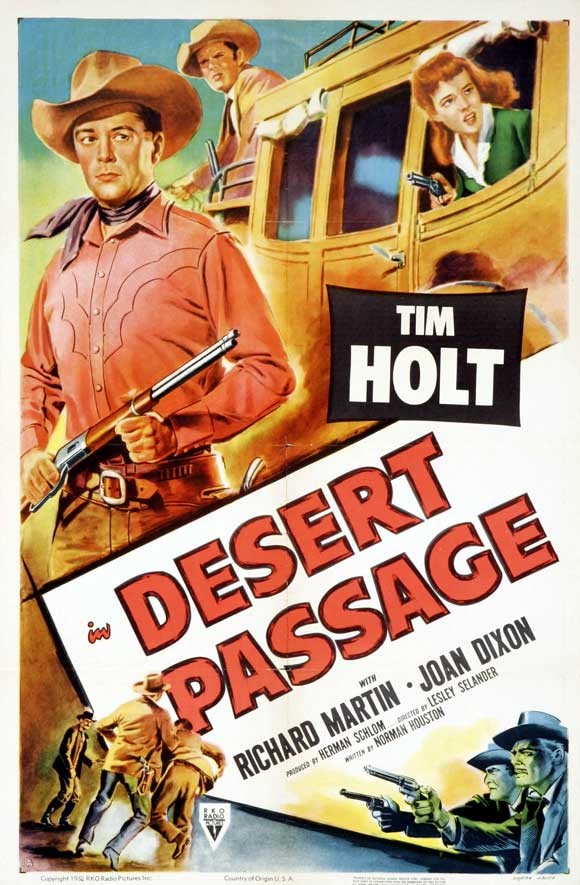
Within the year after the 47-52 Holts started production, they started losing money at the box office. Richard Jewell is the leading expert on the history of RKO, the author of two books on the studio, with his third, dealing with the studio in the war and the post-war era, forthcoming. He had detailed access to all the RKO studio archives years ago before they were scattered to the four winds. He has been able to provide me with budget, film rental (the money sent from the theatres to the studios), and profit and loss statements on several of the films (Jewell: email). Thunder Mountain (1947), the first of the 47-52 Holts had a production cost of $177,000, which is a relatively high budget for a B western. It brought in rentals of $351,000 for a profit of $17,000 (I have neither the space nor the skill to explain Hollywood bookkeeping here). Western Heritage, the following year, cost $173,000, had rentals of $265,000 but a loss of $5,000. Brothers in the Saddle, the next year cost $157,000, had rentals of $205,000, and a loss of $35,000. Even though the budgets went down, the losses continued. For the last Holt film in 1952, the cost was $99,000, rentals of $145,000, and a loss of $30,000. Jewell notes that “The RKO executives often debated the value of keeping the Holt series going in the late 40s and early 50s because the films cost much more than they had in the early 40s and became consistent money-losers during the period” (Jewell: email).
The reason for the decline was simple. After record attendance levels during the war and through 1946, there was a steep decline in movie attendance beginning in late 1946. Film historians have generally credited this drop to the arrival of television, but historian Douglas Gomery has pointed out there were only one million television sets in the country up until the early fifties. He credits the decline in attendance primarily to the people moving out of the cities and into the suburbs to start the Baby Boom (Gomery, 1992: 83-88). In the case of the B western, television may have played a larger role. The B picture studios, like Republic and Monogram, started selling off their old films, many of them westerns, to television in the mid-forties (Gomery, 1992: 247). Even people who could not yet get television because of the small number of stations (such as those in small towns in the South, the Midwest, and the West) were aware that westerns were available on television. When Harry Sherman stopped producing the Hopalong Cassidy films, William Boyd, the actor playing Hoppy, bought up all the rights to the films and the Hoppy stories. Boyd was smart enough to include the television rights, and began selling the old films to television while producing new films. Boyd was also brilliant at merchandising: I had a plastic Hoppy “action figure,” which could be removed from his horse Topper, and when I came home from summer camp in 1950, I found my parents had installed Hoppy wallpaper on one wall. Another wall had Lone Ranger wallpaper, since The Lone Ranger was an early success for ABC starting in 1949. Boyd started doing a syndicated television series in 1948. Gene Autry started his television show in 1950 while continuing to make films until 1953, and Roy Rogers stopped making features and started doing a television series in 1951.
The later Holt features, with their smaller budgets are not as striking as the early ones in the series. The shooting schedules were cut from twelve days to eight. On Border Treasure, the costs of the six-day location trip to Lone Pine were $4829 for travel and $4192 for rentals in Lone Pine, including hotels and meals. Distant location trips to Lone Pine and the Garner Ranch were eliminated, and less interesting locations in the San Fernando Valley were used. The time and money spend on music scores was reduced and the scores suffered. Schlom also ended up using some less talented people. Hot Lead was one Holt written by William Lively. Unlike Houston and Repp, he had no feel for the Tim-Chito relationship. At the end of the film they ride off arguing, something Tim and Chito never did. The film was directed by Stewart Gilmore, one of only six features he directed. He soon realized he was a better editor than director and had a long career as a film editor.
Tim Holt considered going into television, but a proposed deal never went through, probably because the agent handling it for Holt “screwed it all up,” as Richard Martin describes it (Rothel, 1994: 192). Unlike William Boyd, Holt never particularly cared for merchandising. There were no Tim Holt toys, and while there was a Tim Holt comic book from 1948 to 1957, Richard Martin did not think much of the agent who handled that deal, since neither he nor Holt saw much money (Rothel, 1994: 222). So in 1952 Tim Holt simply quit the movies. He later told his third wife why he got out of the business. Talking about his life after his film career he said,
Do you realize that this is the first time in my life that I can make my own decisions and do what I want to do? First it was my parents who told me what to do, then RKO told me what to do, then I went into the service and Uncle Sam told me what to do. I came back out and RKO still told me what to do. This is the first time I have not been under somebody’s thumb in my life. (Quoted by Bardee Holt in Rothel, 1994: 175)
Holt worked a variety of jobs after his film career, including in the oil business in Oklahoma and for radio and television stations. He died in 1973 at age 54.
Richard Martin appeared in three more films and two television episodes after Desert Passage, then got out of the business and into insurance, where he was successful and happy (Rothel, 1994: 184). Dorothy Malone continued in films and television and won an Academy Award for Best Supporting Actress in Written on the Wind (1956). Desert Passage was the last film Norman Houston wrote; he did not go into television. Ed Early Repp wrote two more movies after his last Tim Holt movie, then an episode each for three television series. Lew Landers directed several more B movies after the Holts, then directed episodic television until 1961. Lesley Selander continued to direct films, mostly westerns, as well as television episodes; from 1959 to 1968 he directed 43 episodes of the television western Laramie, and he directed his last western film in 1968. J. Roy Hunt photographed only three more films after Desert Passage. Nicholas Musuraca photographed six more films before turning to television in 1954, where he photographed such varied shows as The Lineup in 1956-57, The Lucy-Desi Comedy Hour in 1959, and 56 episodes of The Jack Benny Show from 1962 to 1965. Robert Swink went on to edit films for William Wyler and Franklin J. Schaffner, getting three Academy Award nominations. After Desert Passage Herman Schlom never produced another film. In 1955-56 he produced three episodes of the television series My Friend Flicka, his final work as a producer. Perhaps Schlom, and perhaps Holt, Martin, Houston, Repp, and Hunt as well, felt that they had done their best work in the 47-52 Holts and wanted to leave the business on that high note. We do not know.
There is one other thing we do not know. In the research for this article I was not able to answer the Mystery of the Wind in the Trees. Watching any group of films, you notice patterns. One that struck me with the Holts was that in scenes in many of the films the wind is blowing in the trees in the foreground while there is no wind in the trees in the background. Once or twice might be coincidence, but not as often as it happens in the Holts. The papers of J. Roy Hunt at the Margaret Herrick Library of the Motion Picture Academy have no details on his work on the Holts. The interviews in David Rothel’s book on Holt make no mention of it. In the RKO Collection at UCLA, the budget reports give no indication of any extra equipment, and on the Daily Production Reports, the box for Wind Machine Operator is not checked off. Since the winds predate the Musuraca-shot films, it may have been something Hunt worked out. Or something that Landers or Selander picked up on early B pictures. Or something that Herman Schlom, who did everything he could to make the pictures as good as possible, hustled past the budget department at RKO. However it happened, the trees glistening in the wind make the Holts just that much better than other B westerns.
Bibliography
Anderson, Christopher. Hollywood TV: The Studio System in the Fifties (1994). Austin, TX: University of Texas Press.
Holland, Dave. On Location in Lone Pine (2005, Revised Edition). Santa Clarita, CA: Holland House.
Erickson, Hal. Syndicated Television: The First Forty Years, 1947-1987 (1989). Jefferson, NC: McFarland & Company.
Everson, William K. A Pictorial History of the Western Film (1969). New York, NY: Citadel Press.
Gomery, Douglas. Shared Pleasures: A History of Movie Presentation in the United States (1992). Madison, WI: University of Wisconsin Press.
Jewell, Richard, with Vernon Harbin. The RKO Story (1982). New York, NY: Arlington House.
Rainey, Buck. Heroes of the Range (1987). Metuchen NJ: Scarecrow Press.
Rothel, David. An Ambush of Ghosts: A Personal Guide to Favorite Western Film Locations (1990). Madison, NC: Empire Publishing Company.
Rothel, David. Tim Holt (1994). Madison, NC: Empire Publishing Company.
Suber, Howard. The Power of Film (2006). Studio City, CA: Michael Wiese Productions.
Terrace, Vincent. Encyclopedia of Television: Series, Pilots, and Specials 1937-1973 (1986). New York: New York Zoetrope.
Online ResourcesTim Holt, Internet Movie Database
Television ChannelsTurner Classic Movies
Encore Westerns Channel
DVDsTim Holt Western Classics Collection, Vol. 2. Warner Archive Collection.
Tim Holt Western Classics Collection, Vol. 3. Warner Archive Collection.
CollectionsJ. Roy Hunt Collection, Margaret Herrick Library, Academy of Motion Picture Arts and Sciences
RKO Studio Collection, UCLA Special Collections
Conversations, emails, AssistanceJoe Adamson
George Bowden
Robert Birchard
Ned Comstock
Julie Graham
Richard Jewell
Chris Langley
Elaine Lennon
Aubrey Solomon
Essay title photo of Tim Holt taken from the NNDB website.

